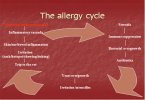By Dr. Karen Becker, DVM
Does your pet
Sneeze and cough?
Have swollen paws or inflamed ears?
Have gastrointestinal upset?
It could be that allergies are wreaking havoc on their system.
Just like in people, your healthy pet’s immune system should react to bacteria and viruses by manufacturing antibodies that allow its body to mount an immune response against these unwelcome invaders (pathogens).
Your pet’s immune system also encounters hundreds of particles every day that are not harmful, rather are just part of the natural environment. Under normal circumstances, these substances (ragweed, grasses, pollens, molds, foods, etc.) should be recognized by the body but not be considered foreign invaders.
In the case of pet allergies, however, an over-active immune system processes and interprets common substances as a toxic assault. And when your pet’s body mounts an immune response to common, normally harmless substances, or allergens, allergic symptoms appear.
Food Allergies vs. Environmental Allergies
There are two types of allergic responses that pets can experience: food and environmental. Your companion can be allergic to one type of tree or every outdoor allergen, allergic to only wheat or every starch. Some pets even inherit sensitivities to certain foods and environmental factors, and in these cases often demonstrate allergic symptoms early in life.
For other pets, allergies are acquired over several years of continual exposure to the allergen.
What may your pet be allergic to?
The truth is, animals can react to anything in their environment -- even water is a possibility if it’s contaminated with impurities. Collar and bedding materials (cotton, etc.), cleaning supplies, household chemicals and dust mites are all relatively common household allergens that could cause your pet to have an allergic reaction.
As you’re trying to figure out what allergen is causing your pet a problem, keep in mind that some pets have both food and environmental allergies. If your pet itches during the spring, summer or fall, they are most likely reacting to something they are exposed to at that time. But if your pet continues to have allergic reactions after outdoor allergens have been buried under snow, it points more toward a non-seasonal, or year-round source of allergy, such as food.
That said, if you live in an environment that does not have a hard freeze in the winter, environmental allergens can really build up and cause year-round issues for our companions. Allergy testing can be done to determine what substances your pet is reacting to at that point in time. Allergy panels can yield very different results when conducted over several months, demonstrating that the immune system can over-react to many different substances at varying times of the year.
Why Feeding Your Pet One Food for a Lifetime May be Problematic
I commonly hear people say, “My pet can’t be allergic to her food, she’s been eating it her whole life.”
This is the point, exactly! Food allergies have been shown to occur more in pets that are fed only one food source for a prolonged period of time. Your pet’s immune system can become bombarded with the same allergens for so long that it begins to react negatively to the food source.
The foods most commonly found to be allergenic to dogs and cats are:
Wheat
Corn
Chicken
Beef
Surprising?
Not really, as dogs and cats were never meant to ingest foods containing such high amounts of carbohydrates (the average commercial dog food contains over 50% grains), and were certainly designed to consume more than one protein source over a lifetime!
If you suspect that your pet has a food allergy, a food trial, or allergy elimination diet, can help you figure out which foods are the problem.
Conducting an Allergy Elimination Diet
Once your companion has developed an allergic reaction to a substance, those reactive antigens can circulate in his bloodstream for up to 6 weeks, causing inflammation and irritation.
This means that an allergy elimination diet should last at least six weeks, sometimes longer (I recommend a full 3 months).
During this period, pets must not eat any foods or treats suspected of causing a reaction. A single bite of a problematic food can cause a flare up that lasts several days, so complete elimination is essential for the process to be successful.
After your pet has been given adequate time to clear the allergic substances from his body, new foods can be added slowly back in, as you watch the animal’s response after each food is added. Interestingly, many of the foods that were previously considered allergenic can often be incorporated into the diet once your pet’s body has had ample time to detoxify and clean out cellular debris.
Many holistic vets theorize that it’s not the actual food protein that causes the immune system to react but the chemicals and preservatives included in the foods that cause the problem. Although we can’t say for sure, this would explain why, after making the correct dietary changes, many pets can then consume foods that they were previously allergic to.
Allergy Symptoms Can be Diverse
It’s critical for pet owners to recognize that allergy symptoms are very diverse, and expand beyond the typical itching or sneezing. They include:
Itchy body
Red eyes
Nasal discharge
Oozy skin
Asthm
Coughing and sneezing
Inflamed ears
Swollen paws
Gastrointestinal disease (vomiting, diarrhea, gas, chronic hairball issues, anal gland problems)
What is the Best Treatment?
Because the symptoms of inflammation are produced from the inside out, ointments, shampoos, sprays and dips can only provide temporary relief and although are beneficial to use for improving your pet’s quality of life during a flare up, long-term treatment must focus on balancing your pet’s immune system.
Steroids (also called prednisone, cortisone or the nondescript “allergy shot”) are the least optimal treatment choice, as they work by suppressing your pet’s immune system. Steroids actually turn the immune system off, which improves the symptoms remarkably fast but doesn’t address the root issue of why your pet’s immune system is over-reacting in the first place.
Not only can steroids have a negative effect on your pet’s liver, adrenal glands and kidneys, but suppressing your pet’s immune system with steroids also allows for opportunistic yeast and bacteria to grow on your pet’s skin, sometimes increasing the chances that antibiotics may be prescribed.
Antibiotics increase the likelihood of yeast overgrowth, which causes your pet to:
Smell like a corn chip
Become insanely itchy, which sends you back to the vet for more steroids
Do you see the crazy cycle? The image below does a great job of explaining it further.
As an aside, keep in mind that healthy pets do not smell bad. Yeast exudes a musty smell, and if your pet smells this way he may have a problem with yeast overgrowth. Many people assume their pets should smell this way, but in reality healthy pets should only be bathed with they’re dirty -- not because they’re smelly.
Bathing smelly pets in oatmeal (a grain) shampoo often adds fuel to the fire, requiring the pet to be re-bathed multiple times a week in order for the owners to tolerate the pet’s odor.
Nutrition is the Optimal Solution
The foods you feed your pet will eventually heal or harm. Feeding pets healing, non-allergenic foods allows their immune systems to rest. Rebalancing your pet’s immune system by offering natural, biologically appropriate wholesome foods is necessary to begin the road to recovery. Also remember that the more variety you include in your pet’s diet, the less likely your pet will be to react to the same monotonous foods. Nutritional variety is not only the spice of life, it’s critical for a balanced and healthy immune response -- and for keeping your pet allergy-free.
Related Links:
Allergies and Skin Problems … What Can You do to Help Your Itchy Pet?
How to Eliminate Annoying Litter Box Problems
Three Simple Sure Fire Strategies to Optimize Your Pet’s Health





